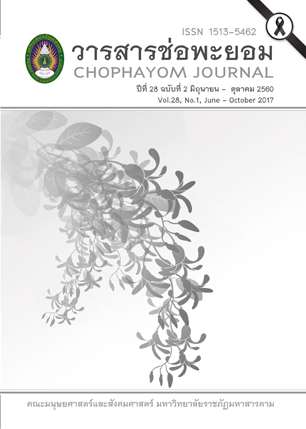แนวทางการฟื้นฟูวัดร้างในภาคตะวันออกเฉียงเหนือของประเทศไทย Study the Situation of Deserted Buddhist Temples In the Northeastern Region of Thailand
บทคัดย่อ
บทคัดย่อ
บทความวิจัยนี้มีวัตถุประสงค์เพื่อศึกษาสภาพ ศักยภาพ และแนวทางฟื้นฟูวัดร้างในภาคตะวันออกเฉียงเหนือของ
ประเทศไทย ประชากรที่ใช้ในการวิจัย ได้แก่ วัดร้างในภาคตะวันออกเฉียงเหนือ โดยเลือกกลุ่มตัวอย่างแบบเจาะจงจากสามจังหวัด คือ ร้อยเอ็ด ยโสธร และนครราชสีมา จังหวัดละสามวัดตามลำดับ ได้แก่ วัดหนองหญ้าม้า วัดบุปผาราม (วัดเก่าโลน) วัดป่าศรีมงคล วัดสระวะ วัดป่านากะหมาน วัดบ้านโพนงาม วัดประตูผี วัดบ้านหนองโน และวัดบ้านตะบอง ผู้ให้ข้อมูลสำคัญ คือ ผู้รู้ในหมู่บ้านที่เป็นที่ตั้งของวัด จำนวน 120 รูป/คน เครื่องมือที่ใช้ในการเก็บรวบรวมข้อมูล ได้แก่ แบบสำรวจ แบบสัมภาษณ์ แบบสังเกต และแบบสนทนากลุ่ม ที่ผู้เชี่ยวชาญตรวจสอบความเที่ยงตรงตามโครงสร้างและเนื้อหาแล้ว วิเคราะห์ข้อมูลเชิงเนื้อหาแบบสามเส้า และเสนอผลการวิจัยโดยวิธีพรรณนาวิเคราะห์
ผลการวิจัย พบว่า 1) วัดร้างในภาคตะวันออกเฉียงเหนือก่อสร้างพร้อมกับการตั้งชุมชนหมู่บ้านของชาวบ้านแล้วสืบทอด
เรื่อยมาจนมีสภาพเป็นวัดร้างในภายหลัง 2) ปัจจัยสำคัญที่กลายสภาพเป็นวัดร้างคือ (1) การย้ายถิ่นที่ทำกินของชาวบ้านและการย้ายไปสร้างชุมชนใหม่ (2) ความขัดแย้งระหว่างกลุ่มอาชีพของชาวบ้าน (3) ในหมู่บ้านมีวัดอยู่สองแห่ง ทำให้เกิดความขัดแย้งระหว่างพระภิกษุต่างนิกาย คือ ธรรมยุตกับมหานิกาย หรือนิกายเดียวกัน (4) การมีแนวความคิดของชาวบ้านที่จะให้มีเพียงวัดเดียวในหมู่บ้าน (5) ความเชื่อของชาวบ้านเกี่ยวกับประตูหน้าวัดหันหน้าไปทางทิศตะวันตกจะทำให้ชาวบ้านเจ็บไข้ได้ป่วยถึงชีวิต และวัดตั้งอยู่กลางหมู่บ้านที่เป็นพื้นที่ต่ำ เวลาฝนตกน้ำในหมู่บ้านไหลไปท่วมขัง (6) เนื้อที่ตั้งวัดมีไม่มากพอที่จะพัฒนาในด้านเสนาสนะและสิ่งปลูกสร้างต่างๆจึงทำให้ชาวบ้านหันไปพัฒนาอีกวัดหนึ่งที่มีเนื้อที่กว้าง และ (7) ชาวบ้านมีความคิดความเชื่อ และขาดความรู้ความเข้าใจเกี่ยวกับการพัฒนาวัดอย่างถูกต้อง และ 3) แนวทางการฟื้นฟูวัดร้างในภาคตะวันออกเฉียงเหนือโดยสรุปคือ จัดตั้งคณะกรรมการพระพุทธศาสนาระดับจังหวัด อำเภอ และตำบล เพื่อบูรณปฏิสังขรณ์วัดร้างให้เป็นศูนย์กลางชุมชนโดยการมีส่วนร่วมของชาวบ้าน จนสามารถดำเนินงานสอดคล้องกับภารกิจหกด้านของคณะสงฆ์ คือ การปกครอง การศาสนศึกษา การเผยแผ่ การสาธารณูปการ การศึกษาสงเคราะห์ และการสาธารณสงเคราะห์ คำสำคัญ : 1. วัดร้าง 2. แนวทางการฟื้นฟูวัดร้าง 3. ภาคตะวันออกเฉียงเหนือ
ABSTRACT
The objective of the research was to study the situation of deserted Buddhist temples in the
Northeastern region of Thailand, their potentials and the measures to renovate them. The purposive samplings were nine deserted Buddhist temples in three provinces, namely, Roi Et, Yasothon and Nakhon Ratchasima, of which three temples were selected from each province. The temples were the following: Wat Nong Yama, Wat Buppharam (Kao Lon), Wat Pa Srimongkol, Wat Sra Wa, Wat Pa Nakaman, Wat Ban Phon Ngam, Wat Pratuphee, Wat Ban Nongno and Wat Ban Tabong. Samples, both monks and laymen, were 120 in number. The tools used to collect the information consisted of survey, interview, observation and group discussion, the reliability of which was endorsed by the research specialists, and, reporting the research results was presented in the descriptive analysis. The research results were as follows: 1) The deserted temples were constructed together with the villages or communities where they were situated, and still remained existing ever since. 2) The findings featured the following main causes of the deserted temples: (1) the migration or relocation of community population to new fertile land; (2) the conflicts or disputes of community residents; (3) the conflicts caused by the different schools of monks who resided in the different two temples in the same village or community; (4) the people’s need to maintain only a single temple in their villages; (5) the people’s beliefs that the temple gate that exposed westwards and that the temple location which was lower than that of the village would cause disasters and bad luck to the village residents; (6) the land where the temples were situated was not big enough to construct some other infrastructures necessary to cover the community that expanded continuously; and (7) lacking the modern knowledge to be applied to the development of the temples. 3) The measures to rehabilitate the deserted temples comprised the following: setting up the offices of Buddhism and administrative committees in both province, district and sub-district levels; re-convention of the temple roles as the centers for mind development, recreation and training of local wisdom; and the application of modern-style management to the administration of the temples in line with the six fields of monastic administration, namely, administration, education, propagation, welfare, educational service, and public service. Key words : 1) Deserted temples 2) Measures to renovate 3) Northeastern region






